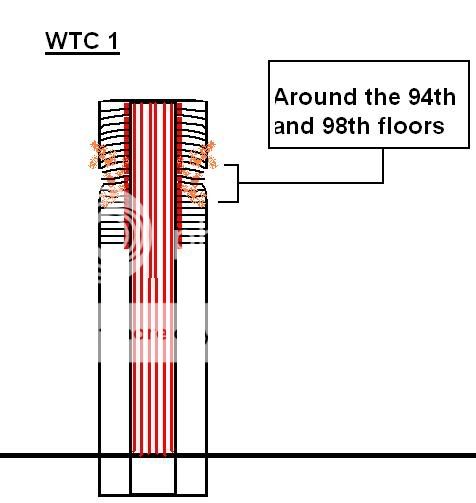It looks like you're using an Ad Blocker.
Please white-list or disable AboveTopSecret.com in your ad-blocking tool.
Thank you.
Some features of ATS will be disabled while you continue to use an ad-blocker.
share:

What I'm describing here is that around the "Weakened trusses and columns" around the main impact area, that you in the end before collapse had this, a base and an upper portion of the building still in tact separated by weakened trusses and buckling columns.
Something to note is, to not just heat the trusses and weaken them, you would have to have efficient concentrated fires working on each truss to assure substaintial weakening to allow them to sag. So we're talking about a furnace here, working on more than just a majority of the trusses to allow almost total failure to cause almost most of the columns to buckle.
Alright, back to the picture, this is more or less like I said what you'd have. Now what Howard said is that:
The exterior columns were responsible for 50% of the load bearing capacity of the building.
By the way, do you have a direct link to a source for this?
Eitherway, you still have a still intact central core that was claimed to of not been significantly weakened enough by the fires to cause the collapse.
I'd like to point out with this, you then have sort of a tree like set up, with branches (the trusses) sagging down off the side of the building, with the columns bowing down, held together at the top by a tree trop.
What's wrong with this picture? You have a core that's still in tact, still carrying 50% of the support.. that is according to Howard (with respect to the 50/50 support). And that's with total 100% failure of the trusses around the collapse zone, as I said, there is a top portion and a bottom portion in tact.
I'm not suggesting that the building would of stayed standing. What I am saying in part, as a theory, is that the outer columns above the failed trusses began to hangdown due to no support underneath from any columns because they were all buckled, but as they took on stress, they fell and onto quite a few floors below the impact zone in which they met resistance.
Only problem is, how do you successfully take down the core when there wasn't total failure of the trusses and columns around the perimeter of the impact zone? Also, if the core wasn't substaintially damaged and because the columns didn't have support underneath, causing them to fall and give out due to the stress, that was less mass you had that was needed to be held up by the core which was still in tact, causing less stress trying to force it down by gravity working on the remaining top trusses/floors/columns. And let's not forget the other interesting pieces we've looked at:
- The yellow hot liquid metal pouring out of the building
- The fact that fires were oxygen starved, meaning the fires towards the outside would of yielded more intensity, based on how much fuel
(officesupplies/building supplies were available)
- The fact that as the upper portion fell, the force and momentum of the collapse was so great that it pulverized debris as it came down
- The core was not significantly weakened
- There was not total truss failure or very significant truss failure around the perimeter of the impact zone
- The force of the building coming down, seemed to of completely obliterated any resistance it met along the way
- Fire temperature/fuel/heat/air all varied in different parts of the building, leaving some areas more concentrated with heat than others and also
some areas with less fuel, some with less oxygen, some with more oxygen.
- Fires fueled by jet fuel only burned so hot for so long, briefly in perspective of how long the building lasted 1/4-1/5 of the time (WTC 1
especially, WTC 2 was different as it had more jet fuel consumed on the initial impact, leaving less fuel to seed fires around the building..
however.. this building did fall first..)
So I still don't understand how the core was brought down from the upper floors/trusses/columns (ESPECIALLY with WTC 1 as the zone of impact was so high above the tower, that's less mass/stress to consider on the core if the outside columns were buckling, than it were farther down, no?) above the impact zone.

Originally posted by Masisoar
I'm still peeved that the debris from the World Trade Center disaster...
IMO that act was criminal in of itself. I'm surprised investigators did not make more of a stink about how quickly things were whisked away. In a criminal investigation you need to find evidence and you obviously can't do that when it's all in a dump... Oh wait, I forgot they found the passports of the terrorists and had a list of their names that same day.
This is what I posted in the thread regarding thermite:
I guess their agendas fill different thoughts, atleast that's what it appears to represent at this point.
[edit on 6/9/2006 by Masisoar]
I believe, that if it was due to structural integrity of the building that it fell (not being able to withstand the fires), that there should be amounts of left over debris from key areas around the impact zone and other areas of importance.
Because then it becomes an importance as to why it fell. Since it poses such a great threat to future business/skyscrapers around the world, it would be very beneficial for safety reasons to be able to loan out steel from those important areas for further study by other architectual and building companies/contractors.
However, it was solely up to FEMA and the NIST to study the steel and make the best possible "speculated" view as to why it fell, with steel being kept locked up afterwards or sent off.
I believe it was great irresponsibility that such a thing not be done considering the importance of such an engineering danger.
I mean, if you can by all means, produce an article or some sort of proof that there is debris from the majorly affected open for study somewhere, then that'll lay many of my suspicions and I'm sure that of others on this board surrounding the clean up and handling of the 9/11 materials.
I mean the NIST and FEMA already made their case, what further use of the steel do they need?
I guess their agendas fill different thoughts, atleast that's what it appears to represent at this point.
[edit on 6/9/2006 by Masisoar]
new topics
-
Paradox of Progress
Ancient & Lost Civilizations: 3 hours ago -
Joe Biden gives the USA's Highest Civilian Honor Award to Hillary Clinton and George Soros.
US Political Madness: 6 hours ago -
Winter Storm
Fragile Earth: 7 hours ago -
Biden Face Planted Somewhere
Politicians & People: 8 hours ago -
A great artist and storyteller, for kids of all ages
General Entertainment: 9 hours ago
